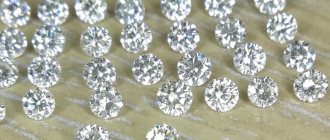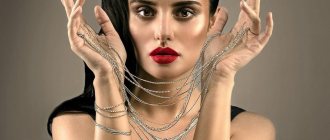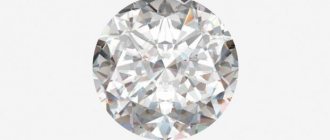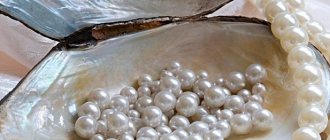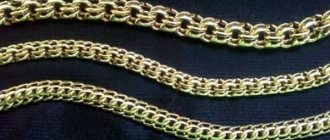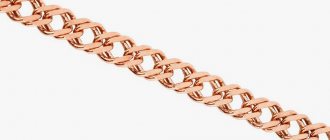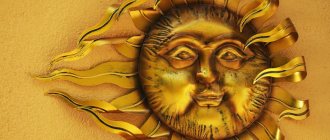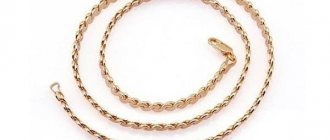It’s amazing how the same stone can awaken the most different intentions and aspirations in a person - there has been an unfair struggle for diamonds for centuries, today these precious stones are the most valuable exhibits at exhibitions, and the cost of diamonds at auctions grows to unimaginable limits. Diamonds evoke the brightest emotions, delight, but at the same time give rise to dark thoughts inspired by the desire to own the treasure alone.
| The most expensive diamond “Pink Star” (59.6 carats, Sotheby's, Hong Kong, $71.2 million) |
In the world of jewelry, everything is not so categorical; diamonds in products and accessories are represented so widely that every buyer can choose stones in any price category, literally starting from several thousand rubles.
Where is the best place to choose diamonds?
As a rule, it is recommended to purchase precious stones in jewelry stores. This way, you can assess the quality of the stone in a relaxed atmosphere, and, if necessary, look at the gemological certificate, which contains data on weight, clarity, type of cut and other parameters. In addition, if you suddenly have complaints about the quality of a gemstone, you can contact the salon and sort out the problem.
Some people choose stones from specialized online stores or at auctions. But, before making any online purchase, read reviews about a particular online site and thoroughly study the history of the company.
Choosing silver earrings
Despite the fact that silver is many times cheaper than gold, it is rightfully called a noble metal. This means that choosing silver earrings that fully meet your needs is much easier - you don’t need to put price at the forefront. The frame is definitely high 925 sterling silver.
Silver is not as pretentious and demanding as gold, so even for everyday wear you can choose quite voluminous and richly decorated options: rings, massive earrings in oriental or vintage style, jewelry with Slavic symbols, with or without pendants. Nowadays, the trend is bright and provocative bows, which will certainly appeal to lovers of bright, voluminous jewelry.
Chain earrings are especially popular now, and not just elegant, thin ones. Tassel earrings with a dozen chains, pendants in the form of several large links, and “pins” decorated with fragments of a coarse chain look impressive. Rings in all forms are also trendy: from classic to vintage, oriental and gypsy.
Silver tassel earrings in the SUNLIGHT catalog
The list of stones is also expanding. Not only precious stones of the first category are set in silver, but also simpler minerals: turquoise, malachite, onyx, aquamarine, garnets, chrysolites, zircons, topazes - in short, almost all stones used in the jewelry industry. And if you add organics here (pearls, ivory, amber, and even valuable wood, trendy in the 2021 season), the choice becomes truly endless.
How to choose a diamond according to characteristics
Diamonds are used to set rings, bracelets, pendants and other jewelry. You can also purchase a gemstone separately, for example, to set it in a piece of jewelry made to order.
If you don't know how to choose diamonds when purchasing, a diamond certificate can help you. It is issued for all diamonds of natural origin and weighing from 0.29 carats. A document confirming the authenticity of stones is issued, for example, by the Gemological Center of Moscow State University and the Russian Gemological Laboratory, as well as various international organizations such as GIA, HRD Antwerp. The certificate contains:
· information about the manufacturer;
· Name of product;
date of manufacture, dimensions of the stone;
· type and grade of frame material;
· type and quality of cut.
Before choosing diamonds, read the certificate. Also consider a number of other characteristics.
Who issues certificates
The first thing a diamond buyer does is look at the quality certificate that comes with the stone. Guaranteeing authenticity is especially important if the item is purchased as an investment.
An international certificate guaranteeing quality and accurate evaluation is issued by the Gemological Institute of America (GIA). The second organization is HRD, but its testimony is less popular. In Russia, this is the competence of the Moscow Gemological Center and other institutions.
The document states:
- stone quarrying site;
- place of processing;
- weight;
- color;
- purity;
- degree of fluorescence;
- presence and nature of defects.
Such a certificate is an authoritative proof of the declared characteristics of a diamond.
Carat
The weight of diamonds is measured in carats (ct). One carat is equal to 0.2 g. This is how much one carob seed, which grows in the Middle East and the Mediterranean, weighs. Diamonds are divided into three types based on carat content:
· small - 0.29 ct or less;
medium - from 0.3 ct;
· large - from 0.7 ct.
As a rule, jewelers encrust rings and rings with large diamonds, while smaller options are chosen for earrings, brooches and other jewelry.
It is worth understanding that the weight of a gemstone does not always correlate with its size, but the price of stones of different categories can vary greatly. Thus, stones weighing 0.99 carats visually look the same as one-carat diamonds, but are slightly cheaper than the latter.
Purpose of earrings
All earrings can be divided into everyday and for going out. The first ones are small, with a laconic design. As a rule, they are encrusted with small stones, which look appropriate for daily wear. In shape, these can be neat studs, small rings and half rings, or short earrings with a traditional English lock.
Earrings for going out are more complex in design, often with an intricate design. They are made using large diamonds or a scattering of stones. They are larger in size than those worn daily. Often these earrings are of considerable length and can even reach the shoulders.
Cut
Its brightness and appearance depend on the quality of stone processing. The type of cut and the accuracy of the angles determine the brilliance and beauty of a diamond. The quality of the cut is assessed on a letter scale:
· A - higher;
· B - good;
· B - average;
· G - low.
If you decide to choose a diamond ring or earrings, an important characteristic will be the cut shape. The classic version is considered to be a round cut with 57 facets. Stones cut in the shape of a heart, drop, square, rectangle or oval look original.
HOW TO DECODE A TAG
The tags indicate the weight of adamant, its shade, transparency, shape and type of cut, the presence of inclusions, and shine.
So, if the tag says “5Br-P49–5.5ct–2/3B”, this means:
- “5Br” - there are 5 adamants in the jewelry;
- “P49” is a cut. Each of the 5 diamonds has 49 facets and is cut into a Princess (P) cut.
- “5.5ct” is the sum of the mass of 5 stones;
- “2/3”, 2 – color, 3 – purity (according to the International VVS2 scale);
- “B” is the type of cut, that is, deep cut.
When purchasing a ring, you need to examine it from the inside. If the stamp says PT (Plat), which means “platinum,” you can be sure that this is a real diamond, since zirconium is never combined with platinum.
The letters CZ mean it is zirconium.
Color
Colorless stones
Transparent stones are considered the most valuable. Colorless diamonds are divided into nine groups. The first group includes absolutely transparent stones, and the ninth group includes brownish or visible yellowish stones. Stones of groups 3–5 are considered popular. There is also a letter-based international classification, in which the color of stones is distributed from D to Z.
It is impossible to visually notice the difference between the stones of the third and fourth, as well as the fourth and fifth groups. At the same time, the difference in price is quite noticeable. Therefore, when the question is which diamond to choose, the decision depends on whether you are willing to overpay.
Colored stones
The cost of colored diamonds is affected by the brightness and saturation of the hue. Most often, colored options are cheaper than colorless ones, but there are exceptions. Thus, stones of the so-called fancy colors can be more expensive than the most transparent samples.
Diamond Categories
The cost of a cut stone directly depends on four parameters - the color of the diamond, its clarity, quality of cut and carat (weight, 1 carat = 0.2 grams). The higher all these indicators are, the more expensive the diamond is valued. Unique characteristics are not found very often, and such clean, perfectly cut stones, each in its own category of color and weight, are auction items and are found in private collections. The cost of diamonds in this category amounts to hundreds of thousands and tens of millions of dollars.
Jewelers use the 4C rule to evaluate stones: Carat/Color/Clarity/Cut – weight, color, transparency (purity), cut. Each category has its own characteristics, and they are not always clear to everyone who is far from the jewelry profession. But even the basics that allow you to understand the value of diamonds will be enough to choose and buy any other jewelry with a diamond that has a truly decent value.
Diamond carat
In the ancient times of the Ancient East, when the equipment available to modern masters of precious stones and metals could not even be dreamed of, the weight of diamonds, like other stones and even food products, was compared to the seeds of the carob (Caribbean) tree. Ceratonia capita in Latin has a name consonant with the word “carat” - cerátiοn. The stable mass of these seeds, equal to 0.2 grams, became a measure of weight, among other things, for diamonds.
One such grain is the equivalent weight of a diamond of 1 carat (Ct). But a diamond, even a faceted one, has a special property: stable, unchanging density. This quality became the basis for grading the carat of diamonds according to their diameter (or width in millimeters). You can measure these values and correlate them with the carat table, the values will be identical, and the differences will be tiny and meaningless.
For diamonds weighing more than 1 carat, this rule applies in the same way; the ratio of the diameter of the stone and its weight can always be compared with the data in the table and the results of weighing on special equipment - there will either be no discrepancies at all, or their presence will be reduced to a slight minimum.
The joke that a real woman can determine the carat value of a diamond by eye without a scale is not a joke at all. The photo clearly demonstrates the relationship between size and carat weight, assuming the diamond is on the finger.
Of course, remembering all the sizes is not so easy. But for fans of diamond jewelry, there is a proven life hack:
- if you take as a basis the smallest diamond, half a carat, and the largest, 7 Ct, and also remember how a 3-carat stone looks on your hand, all other intermediate values can be determined by focusing on the larger and smaller sides of the average size.
It is worth remembering that this data can only be applied to diamonds, the data is derived relative to their density. This system is not suitable for sapphires, rubies, topazes and other precious stones. Visually, a 1 Ct diamond and, for example, a ruby will be different sizes; corundum is noticeably larger than a diamond with equal carat stones.
Diamond color
To distinguish diamonds by color, a universal international designation system has been developed using the GIA (Gemological Institute of America, an independent organization) method, where the gradation is designated by the letters D to M.
Colorless diamonds are the most expensive on the jewelry market; these are stones of categories D, E and F. Understanding the difference between stones of this highest category is the work of a specialist with extensive experience. Such diamonds belong to the investment group and are used in exclusive jewelry or for storing and increasing funds. The cost of such stones increases by 10% annually.
GH is the second category, such diamonds are also quite valuable, but have a lower price due to a barely noticeable yellow tint.
All other diamonds, from I to Z, belong to the group of inexpensive colorless stones and are most widely used in jewelry.
In addition to the international GIA system, there is a Russian gradation: it is more complex and is designed primarily for professionals - jewelers, appraisers.
The color relationship between GIA and Russian parameters depends on the carat of the diamond and for this reason there are some discrepancies between the data of the international and Russian classifications.
Among other things, the Russian scale has developed a color rating system for diamonds with different cuts - 17 facets, 57, and so on. This part of the gradation is needed only by jewelers to certify stones.
Light transparent stones are not the only existing standard; cut diamonds can have different shades and sometimes the usual colorless diamonds are not so interesting and are not valued highly enough against the background of blue, green, pink, and gold shades. Therefore, for all diamonds that have a different color, the Fancy group has been developed - fantasy shades. The darker the color, the higher the cost of such a diamond.
Diamond Clarity
Assessing color without the clarity of a stone is almost pointless; these parameters are interdependent, although it is very difficult to find a stone with an ideal relationship between color and clarity - these are expensive, rare, beautifully cut diamonds. Moreover, only a professional can give an objective assessment of this parameter. Clarity
or transparency - a parameter showing how many defects a stone has and how much these inclusions affect the appearance of the diamond.
Nature has not yet created a single diamond without a single inclusion, and if you see a stone with perfect transparency, in which even the smallest, insignificant defects are completely absent, it is a fake.
As in the case of color, jewelers use the international GIA system and the Russian scale. The GIA scale includes 11 classes, in which defects can have varying degrees of visibility, be located inside the diamond, on its outer surface and, depending on the intensity and location, affect the clarity of the stone. The Russian scale, as in the case of color, is more complex and classifies the clarity of a stone not only by the presence of inclusions, but also in their relation to the weight of the diamond and the number of facets.
The buyer can rely on a simplified purity assessment system presented in the table (the ratio of the letter GIA to the Russian number scale)
It is worth remembering that diamonds of category IF ( INTERNALLY FLAWLESS
) are the rarest, unique stones, the defects of which are reduced to damage to the outer surface that is barely visible even under magnification, provided that they can be reduced by polishing. Such diamonds are the main participants in prestigious exhibitions, the most expensive lots at prestigious auctions at the level of Sotheby's or Christie's.
We are sure you noticed a beautiful blue diamond at the beginning of the article - this is a Winston Blue, a stone of the highest, impeccable purity, weighing 13.22 carats, which was sold during one of Christie's auctions for $24.2 million. A cushion-shaped diamond of the same color, but grade VS2, cost more than $1.8 million per carat in 2013.
Large stones VS1-VS2 are considered very good, worthy under other conditions of auctions, and VVS1-VVS2 are considered expensive, collectible. For the manufacture of jewelry for mass sale, with small diamonds, up to 0.3 carats and a little higher, stones of categories SI 1-SI 2 are used, and for quality products even categories I1-I3 (6-12 positions on the Russian scale) are not used. If you want to buy a good diamond, its transparency should not be lower than SI3 on the GIA scale, that is, 7/7a according to the Russian gradation.
Data about diamonds is indicated on the product tag or in the certificate, and now you can easily decipher the meanings.
Diamond cut
This parameter alone may require a separate, impressively voluminous article, so we will only touch on the most popular types of cuts. In total, cutting methods number in the dozens, and the numbers tend to hundreds of options. But not all are used in modern jewelry - there is no need and, probably, suitable stones. Like all previous parameters, the cut that turns a diamond into a beautiful diamond is judged by its quality. And the main requirement for processing is the creation of geometrically accurate, preferably flawless, edges and their proportions. The number of sides also differs, depending on the style:
- 17 facets - simple type of cut
- 33 – Swiss style
- 57 – classic full Tolkowsky cut
- 73 – “highlight-cut” type (increases radiance)
- 86 – royal cut
- 102 – majestic, only for large diamonds
These forms are used constantly today, and the choice of cut type always depends on the initial quality of the diamond and its characteristics. With the help of the right cut, you can give your future diamond maximum brilliance, and the precise placement of the edges will help hide defects or at least make them less noticeable.
All types and shapes can be divided into three categories - brilliant cut, step cut and mixed cut. Each has its own advantages: for example, stepped
The emerald and asscher cuts are perfect for clean stones and only highlight the natural characteristics of diamonds.
Diamond
cut - one that is based on the principle of best light refraction, can have 57 facets and more. Such stones demonstrate an incredibly bright, multi-faceted shine, and are used in most cases for round diamonds and all where a rectangular or square shape is not required. It is because of the ability to bring out the best characteristics of a diamond and transform it into a beautiful diamond that this form is used more often.
Mixed
cutting is an opportunity to preserve the weight of a diamond, its quality, color; it is successfully used if the stone has a number of flaws that are required and possible to hide, and at the same time emphasize the shine and light reflective qualities of the stone. This method was invented in the middle of the last century in Sri Lanka, and to this day the method is successfully used in princess, radiant, and pear (aka drop) cuts.
Choosing a cut is not an easy matter, and jewelers make a lot of calculations before starting to process a diamond, and the final decision may come months after the first acquaintance with the diamond. Still would! The cut literally decides the fate of the stone: a wrong decision will ruin the stone, turning even a very clean diamond into an unusable diamond with even one imprecise cut.
Purity
Before choosing jewelry or stones separately, consider not only the carat value, but also the clarity of the diamonds. The radiance of stones is determined by their ability to transmit light rays: the lower the purity index, the less pronounced their shine.
Absolutely pure stones without any inclusions are quite rare, which affects their cost. Such samples are often sold without frames, and they are subject to mandatory certification. To assess the clarity of diamonds, there is an international scale consisting of 11 levels: from IF - an absolutely pure stone, to I3 - a diamond with defects and inclusions.
The Russian classification provides:
· for small stones - 9 purity groups;
· for large ones - 12 purity groups.
Perfectly clear diamonds receive a 1, while those with noticeable and/or numerous inclusions receive a 12.
If your goal is to choose diamond jewelry for beauty and not for investment, take a closer look at diamonds that belong to groups 3–4 in color and 1–7 in clarity. As a rule, it is better not to purchase stones of levels 9–12 - due to numerous defects, they often split and do not look very attractive.
How to choose the right earrings?
To choose the right earrings, you need to take into account some anthropometric parameters of their future owner:
- Face shape. This is perhaps the most important parameter that should be taken into account when choosing earrings. If your face has the correct oval shape, you don’t have to limit yourself to anything. Chubby people should choose narrow and long models, while those with long faces should choose wide earrings.
- Height. Voluminous earrings with long pendants look best on tall ladies. A miniature girl with such jewelry will seem even smaller, but the earrings will appear disproportionately large.
- Age. The brighter and more elaborate the earrings, the less attention to the face. So very young princesses need to choose very small earrings, both from the point of view of comfort and aesthetics. And ladies of an elegant age are allowed brighter and more elaborate models - they will draw attention away from annoying signs of age and fatigue. But it should be really high-quality and expensive jewelry, and not costume jewelry.
- Ears. If the ears are protruding or have a clearly irregular shape, it is better not to draw attention to them - laconic studs are enough. But even shortcomings can be turned into special highlights - not very practical, but stunningly spectacular elf earrings will be an interesting find for creating unusual images. Asymmetrical or stretched holes can be disguised with a richly decorated front part of the decoration. And for those with very thin or weakly defined earlobes, heavy earrings that pull down the ears are clearly contraindicated.
Choosing earrings for a girl as a gift without her presence is quite problematic, so it is better to visit a jewelry store together. Let this no longer be a dizzying surprise: but you will know: you will definitely like the gift!
24.02.21
How to choose diamond jewelry: criteria for determining quality
Each piece of jewelry is attached with a tag indicating its characteristics. The same applies to large expensive diamonds that are sold without a setting. Let's look at an example of how to read a tag. Let's say we see the following: 5 KR-57 0.7 2/2 B.
What does it mean:
· 5 - the total number of diamonds in the jewelry;
· KR - cut shape, in our case, round;
· 57 — number of faces;
· 0.7 - the weight of one stone or the total weight of all stones in the decoration;
· 2/2 – color and clarity of diamonds on a scale from 1 to 9;
· B—cut level.
What to remember when buying a diamond
A professional gemologist or jeweler will help you choose the right jewelry. But since it is not always possible to take a knowledgeable person with you, it is advisable to remember several points:
· Decide on your purchasing budget. Consider how much you are willing to spend on a piece of jewelry or gemstone.
· Select several options, compare them with each other based on their main characteristics.
· Choose the product that best suits your price and quality.
· When purchasing a diamond, pay attention to the certificate - it must contain a detailed description of the stone’s parameters.
Experts recommend choosing jewelry with stones that have average gemological indicators - in the range from 3 to 5 (on a scale of purity, color). Such diamonds look decent in jewelry, and their cost is not prohibitively high.
The most popular and expensive diamonds in the world
The mystery of these incredibly expensive diamonds will never be solved - what motivates everyone who buys a stone for twice or more than the starting price of the auction? Probably, diamonds really have the ability to control the will of a person. We don’t argue, for example, Oppenheimer Blue
– it is magnificent, although not as large as other high-grade diamonds, only 14.62 carats.
The initial cost of this luxurious blue diamond was only $30 million, and was a third lower than the estimate - just over $40 million. This did not prevent the diamond from finding a new owner for $57.5 million.
We agree: the diamond has an ideal combination of color with the best cut shape for it, and excellent companions were used.
Not every diamond is worth fabulous millions, but many of the stones have historical value. Like the next example, the famous Archduke Joseph.
The stone is named after its owner, Joseph Augustus of Austria, great-grandson of Louis Philippe, the French king. A diamond would be a standard of purity if it were exhibited in museums. Color of the highest category D, flawless cut, giving the diamond an unusually soft shine. The family jewel of the Archduke's family weighs 76.02 carats, and was put up for auction at Christie's in 2013 for $15 million at an initial cost.
The final blow of the hammer fixed the price at $21.48 million, and the diamond passed into the possession of an anonymous buyer.
There are many more examples that can be given - the Pink Star diamond, sold for $71.2 million, the Orange (gold diamond, worth $36 million), the pink Prince diamond ($39.3 million), the Marie de Medici diamond and other “stars” of the jewelry podium. They are all beautiful and inaccessible, as everything exceptional should be.
How to distinguish natural stone from synthetic
Artificially grown diamonds are similar in physical and optical characteristics to natural ones. They are almost completely identical, except that synthetic stones are created in laboratory conditions.
Experts will help you accurately determine the origin of a gemstone. It is also quite possible to independently verify the authenticity of a diamond: for this you will need an ultraviolet lamp. Under the influence of ultraviolet light, natural stones glow with a light blue hue. Synthetic counterparts will typically have a yellow or green cast.
Earring shape
Earrings can significantly change your appearance. It is optimal to choose them according to your face type and hairstyle.
- Elongated earrings visually lengthen the face. They are recommended to be worn by women with round, square, diamond and heart-shaped faces. To prevent your hair from hiding your jewelry, choose high hairstyles or short haircuts.
- Rings, half rings - on the contrary, look better on oval and rectangle shaped faces, and are also suitable for those who have rather sharp facial features. Visually, they make the face more rounded and smooth.
- Studs and small neat earrings of almost any shape that extend slightly beyond the lobe are universal and suitable for women with any type of face. Hairstyle doesn't really matter either: "babies" look great both when their ears are open and when they playfully peek out from behind their hair.
Of course, it is better to try on earrings before you purchase them: after all, we all have unique facial features. This can be done in our showroom: the assortment includes a wide selection of diamond earrings for both daily wear and “going out” options. And our consultants and gemologist will help you make the final choice: he will show the diamonds in special gemological lighting and tell you in detail about each stone. Please note that all the diamonds with which our earrings are encrusted are certified by the independent gemological center of Moscow State University.
Happy shopping!
How to choose the right diamond ring
When purchasing a diamond ring, consider the size of the piece as well as the shape of your hands and fingers. So, for those with large palms and long fingers, rings and washer rings with large stones are suitable. On petite hands with thin fingers, round and flat rings with several small diamonds will look good.
Focus on your own taste and financial capabilities. If you are purchasing jewelry as a gift, ask about the wishes of the person you plan to give it to.
To choose the right diamond ring, consider a number of characteristics:
· Type of cut. A classic round cut would be a universal option, but jewelry with inserts of other shapes looks no less impressive: “Marquis”, “Heart”, “Princess”, “Drop”, etc.
· Frame material. Platinum, white or yellow gold are usually chosen as the setting for a diamond.
· Weight of decoration. It is good when the product into which the stone is inserted does not look too fragile. Thus, diamonds look quite harmonious in jewelry weighing at least two grams.
· Condition of inserts. Inspect the stones in the ring with a magnifying glass - there should be no scratches, chips or other visible defects on the inserts.
An equally important parameter when choosing is the type of stone fastening. The way the diamond is set determines the design and appearance of the ring. In addition, it depends on how securely the gemstone is fixed in the jewelry.
There are several options for setting diamonds:
· deaf, partially deaf;
· speckled, fadenovaya;
· corner, pavé;
· carmesine, teak;
· invisible.
Buy rings only from jewelry stores that have a reliable reputation in the market. When choosing products with large diamonds, study the certificate of authenticity of the stones.
Beautiful and affordable diamonds – photos
Most likely, you have noticed that diamonds that are not colorless have the highest artistic value. But in real, non-auction life, everything is quite the opposite and it is white stones that have no color, or at least with an indistinct tint, that are used in jewelry. And they are also beautiful and charming.
A good selection of jewelry with good quality diamonds is in our catalog. We are pleased to give all customers an additional 5% discount when purchasing any jewelry online, and also invite you to join auctions to reduce prices.
Wearing rules
According to diamond etiquette, earrings with this stone should be worn according to several rules .
- Large pieces are suitable for evening events, while laconic models can be worn at any time of the day.
- You should not complement earrings with more than two pieces of jewelry. The standard combination is earrings, pendant and ring.
- Small stud models are suitable for young girls, while older ladies can opt for massive accessories.
- Make sure that the frame color of your earrings matches your other jewelry. It is also worth choosing the rest of the jewelry so that the shades of the minerals match each other.
As for the choice of clothes, it all depends on the occasion where you plan to wear the products. Stud earrings, models with an English or French lock, studs will be appropriate for any outfit. They are most harmoniously combined with casual or office style. Bulky clip-on earrings, chandelier earrings, chandeliers and similar models are suitable for long evening dresses, as well as sheath dresses in a festive style.
Thus, we can conclude that diamond earrings are a piece of jewelry that is suitable for any occasion, if you choose the right model. If you don’t want to buy several different options at once, then it’s worth purchasing a universal accessory of modest or medium size with a white stone.
19.03.21
What to prefer - color or clarity
Color and purity are two important criteria that indicate the quality of precious minerals. On the tag they are placed side by side in the form of regular numbers. The first point is given to color, and the second to purity, and it is problematic to understand exactly which of these indicators should be better.
When choosing, the following circumstances are taken into account:
- Priority is given to color if a specific setting is provided for the gemstone. If the frame is white, then visible shades are extremely undesirable. In this combination, the yellowishness will be pronounced.
- Clarity is important if the stone is to be set in yellow gold. This metal will absorb the yellowness. The mineral will visually appear white. True, if its quality is low, the dirt on it will become pronounced. The gem should look absolutely clean.
Purchase authentication technology
In pawnshops, precious stones are valued using the 4C system. Initially, the specialist weighs the gem and thus determines its size in carats. After this, using the correspondence table, the sample under study is correlated with the color scale.
Fancy and completely transparent crystals are considered the most expensive. Choosing a color category is far from an easy task. Initially, the appraiser examines the mineral visually and then subjects it to multiple magnifications.
To give a correct assessment, only tools that do not give glare into the depth of the product are used. Lighting fixtures should emit white, and instruments should only be gray or black.
At the next stage, the specialist determines the purity category. After this, he needs to assess the quality of the cut, how accurately and skillfully it was made. If a mineral is poorly processed, you can even notice it with the naked eye. All other flaws can only be seen with magnification. This also makes assessment much more difficult.


